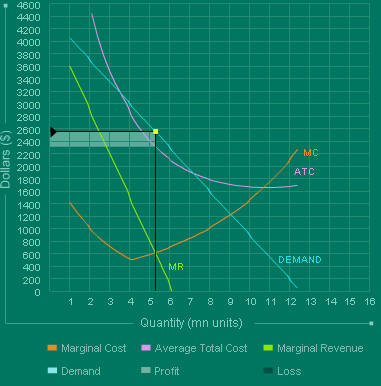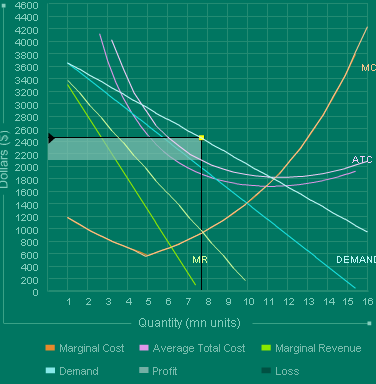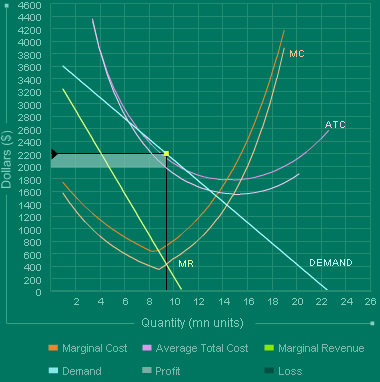Introduction
Strategic marketing is the key aspect of effective sales as well as product promotion. Because these principles are defined by the marketing situation, the key aspect of effective strategic marketing is the proper resource allocation, as well as adequate decision making. Therefore, strategic decisions differ depending on the marketing situation. This paper aims to review strategic management principles of a product depending on the market circumstances, based on the results of the economic simulation.
Monopoly
The pricing strategy on the monopolistic market should consider market demand as well as the production costs. Therefore, considering the product elasticity, it should be stated that the price can not be increased or decreased unreasonably. The price increase means lower demand. Optimal parameters for this situation will be:
- Price $2,550
- Total cost – 12.18
- Total revenue – 13.5
- Total profit – 1.29
Results of these parameters are given on the graph below:

Therefore, this pricing will be the optimal variant, while the other variants will be featured with higher costs and lower profits.
Advertising is the reliable engine of marketing promotion and product development. Therefore, considering the opportunity of stimulating demand, the new concepts should be promoted with an aggressive advertising campaign. Additionally, the increased demand will help to lower the price:
Advertising budget: $ 600 mln, Price – 2,450

Additionally, the growing popularity of the product will stimulate the effectiveness of the advertising campaign. (Anderson, 23)
Considering the necessity to improve the product, the company needs to focus on the production process. While specific improvements and innovations will increase the attractiveness of the product in general, the decrease of the production costs by optimizing the manufacturing process will help to increase demand, as well as lower prices ($ 2,200)

Therefore, as it is stated by Grant (57):
The corporation’s growth strategy has focused primarily on internal new product development, emphasizing both improved products for existing customers and new products for new markets. One formal objective assigned to every business unit is to obtain at least 30 percent of annual sales from products introduced within the past years.
In the light of this statement, it should be emphasized that company development is the cornerstone of effective strategic marketing. Regardless of the opportunities and possibilities of technology development, the improvement of the production process should be of No. One priority.
Oligopoly
The key aims of the oligopoly competition involve deriving the maximum potential of the market, as well as stabilizing the prices. Therefore, there is no need to lower the prices for increasing the market share, as this will inevitably lead to essential losses. Therefore, there is no need to increase prices, as this will distract the target audience. Therefore, the optimal price for the simulation is $1750. This presupposes the maximum revenues, and the optimal production costs, while the profits are the highest.
Monopolistic Competition
When several brands are offered on the market, the actual importance of supporting new brands is explained by the fact that commonly known brands can keep their positions, while the introduction of a new one will help the company to gain higher market positions. As this product will compete with other bands on the market, the overall market share of the company increases. This creates the circumstances of monopolistic introduction, while the other companies do not have similar products. (Johnson, 45)
Perfect Competition
Perfect competition is regarded as the most complicated market situation for manufacturers. The price can not be defined by the vendor, while it is market-defined. Therefore, the only way to increase profits is to reduce the costs. If the company can reduce the costs of the product, this will help the company to make the prices closer to the optimum. Anyway, cost reduction will increase profits, and provide wider capacities for researches, improvements, and innovations.
Anyway, as it is stated by Walker (34), the company should be responsible for attracting and keeping consumers, while this may be achieved by increasing the quality of the product, its uniqueness, and reducing prices. Nevertheless, the cornerstone of these aspects is the necessity to improve the production process. This will help to kill all these birds with a single stone: improved production is featured with reduced costs, and implementation of innovations will be less risky if the manufacturing process is featured with lesser wastes.
Conclusion
Strategic marketing is the key aspect of effective business activity. Because business may be performed within various marketing surroundings, the actions aimed at price forming, advertising, and investments are defined by market realities. The most important aspects of pricing strategy are defined by the capacities of the product, as well as the actions and prices of competitors. Every situation has its optimal solution, however, the simulated situations are perfect, while the terms on the real market are also influenced by additional circumstances and factors. Therefore, strategic marketing should also involve studying these factors, and adjustment of the strategies by them.
Works Cited
Anderson, James. Customer Value Propositions in Business Markets. Harvard Business Review. 2011.
Grant, Robert. Contemporary Strategy Analysis. Blackwell Publishing LTD. Oxford. 2008.
Johnson, Mark. Reinvesting Your Business Model. Harvard Business Review. 2011.
Walker, Mullins. Business Strategies and Their Marketing Implications. The McGraw−Hill Companies, New York 2011.